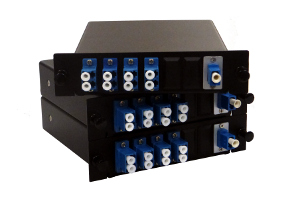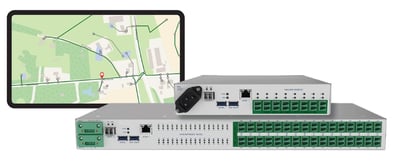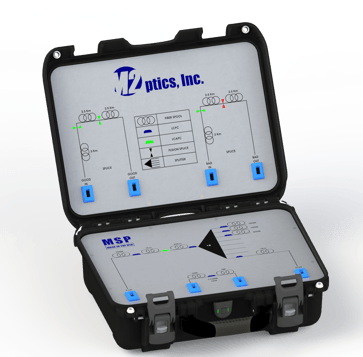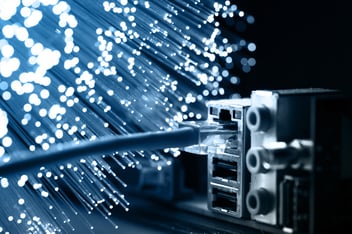Fiber-to-the-home (FTTH), also known as fiber-to-the-premises (FTTP), is when optical fiber is installed and connected directly to a single structure, such as a home, apartment, or business. This approach for delivering high-speed internet services and greater bandwidth continues to excel globally as it offers superior performance compared to non-fiber coaxial cable and DSL (Digital Subscriber Line) connections.
Instead of coax cable and telephone lines, which rely on electrical data transmission and are often limited to delivering a few hundred Mbps at their maximum, fiber optic cables transmit data using light signals which support significantly faster speeds and bandwidth to 1Gbps and beyond. With global consumption of web-based and cloud services continuing to rise in both the consumer and business markets, expanding the optical fiber infrastructure directly to the premises ensures maximum performance while enabling the continuing future developments of even faster technology devices.
According to a March 2022 Global Industry Analysts Inc. report, the global market for FTTH reached $14.1 billion in 2020 and will hit $19.1 billion in 2022. That number will grow by 13.1% (compound annual growth rate) to $29.1 billion by 2026. In the U.S., the FTTH market is estimated to reach $5.3 billion in 2022, a 28.1% global market share. China is second but should see its share reach $8 billion by 2026.
How does FTTH work?
Under a FTTH architecture, optical fiber serves as the primary medium for transmitting data across the entire network and connects directly to homes from the transmission source, often referred to as a central office. Data is transmitted from the central office to the home across what is called the Optical Distribution Network (ODN), which typically utilizes a passive optical network (PON) architecture. PON networks include passive elements like 1xN optical splitters that require no power between the central office and the home, resulting in a more cost-effective and reliable approach to delivering fiber-based services.
The major elements of a typical FTTH network architecture include:
- An optical line terminal (OLT) is located at a central office.
- An optical distribution network (ODN) in between the central office and home/premises, which includes 1xN passive optical splitters for splitting and distributing the signal.
- Optical network units or terminals (ONU / ONT) at the homes/premises.
It is important to note that within the ODN section of the FTTH network, there can be several segments of optical fibers depending on the design architecture. In some instances, a “feeder” fiber originating from the central office may be split into a few “distribution” fibers, each serving a primary cabinet at a neighborhood or complex. At that point, another larger split may occur, with a “drop” fiber to each home. Or, it may be simpler than that, with a feeder fiber from a central office or hub directly to each neighborhood cabinet, with only one split of the signal to the various homes.
The easiest way to demonstrate an example of a FTTH network architecture is using a diagram. The image below, courtesy of EXFO® (a leading manufacturer of fiber optic test equipment), demonstrates the layout and various elements of a typical FTTH network.
Image courtesy of EXFO®website
Lastly, some service providers now offer an option to deliver a dedicated fiber directly to each end user, meaning there is no sharing of the optical signal by different consumers or entities. This results in maximum speeds and bandwidth to each end user, but also typically results in higher service prices. Today, these dedicated fiber services are mostly for business FTTP with significant speed and bandwidth requirements, since installing individual end-to-end dedicated fibers for every single home would result in exponential numbers of fibers being required which is neither cost-effective nor efficient.
What are the benefits of FTTH for a consumer?
Internet speed and bandwidth demands will only continue to grow in the coming decades. With optical fiber being data rate agnostic and capable of supporting significantly greater amounts of data than optical network devices provide even today, FTTH is well-positioned for current and future fiber technology advancements that will continue to deliver faster speeds and more data.
In the last decade, there has been a significant shift in how consumers access entertainment in the home. High-definition video content that requires greater bandwidth is now being accessed by the entire family using multiple types of devices including smart televisions, smartphones, tablets, laptop computers, and video streaming devices like ROKU. This content comes from various sources, including YouTube, Netflix, Amazon Prime, Apple TV Plus, and more. The explosion of online gaming, or eGaming, should also be added to this list as both children and adults can download and play video games or participate in competitive tournaments.
Additionally, most consumer services are now accessible online, ranging from purchasing new items via eCommerce shopping websites and paying household bills to accessing online banking, executing stock and financial trades, remote classroom learning, connecting to healthcare-related systems, and maintaining relationships with friends and family via popular social media portals.
Cloud computing has also taken off in recent years, even before COVID-19 forced many to work from home, with remote work-from-home jobs expected to continue growing globally. With cloud storage and computing enabling remote access to required business systems and software applications, residences and businesses need fast and reliable connections to access digital data stored off-premises for performing job functions effectively while participating in video conferencing sessions.
Lastly, products for the home falling within the Internet-of-Things (IoT) realm like home security systems and devices for managing home utilities (turning on/off lights, changing room temperatures, etc) are another reason FTTH provides an advantage. Allowing for faster speeds and more data, consumers can now implement web-based video monitoring to protect their property along with these other IoT systems.
In short, to support all of these internet-driven services and products which consume large amounts of data, optical fiber, and FTTH/FTTP networks offer a significant advantage over legacy coax and DSL/telephone line services.
What are the benefits of FTTH over coax and DSL?
There are many benefits to using FTTH versus legacy technology such as coax, hybrid fiber-coax (HFC), and DSL. In the article, most have already been noted, with the primary being that optical fiber supports faster speeds and greater bandwidth. Additionally, using optical fiber helps to "future-proof" the network, as it will support significantly greater performance capabilities well into the future. In other words, the limiting factor in a fiber network is not the fiber itself, but rather the capabilities of the devices and transmission technology - as that continues to advance, optical fiber will continue to support it for the foreseeable future.
Additionally, there are other benefits that using optical fiber offers compared to legacy approaches like copper-based coax and DSL systems. These include:
- Greater resistance to environmental changes like temperature fluctuations
- Immunity to electromagnetic interference (EMI).
- More cost-effective, lightweight, and space efficient
Optical fiber and fiber optic cables can be made for less than the equivalent length of copper wire. It is now the primary transmission medium used for most communications networks, but in many cases primarily used for the major key routes, while the “last mile”, i.e. the segment from main hubs to the home, is still coax in many instances. Due to the benefits noted in this article, most of the newer networks are now shipping legacy technologies altogether and installing both fiber and fiber-based devices throughout the entire network (or as far as possible/permitted within the scope of the project).
What are some challenges of FTTH?
While FTTH offers numerous benefits, like anything else, some challenges can arise when constructing or delivering FTTH network access and services
First, in order to upgrade to an all-fiber network or install a brand-new fiber network, a service provider must have adequate access to be able to do this successfully. It may require permits from local municipalities, approved rights-of-way, or even resistance from other service providers that currently own the rights to the existing infrastructure necessary for providing FTTH who do not want a competitor in their area. Thus, there can be a lot of obstacles of this nature and administrative-based challenges before even getting started with construction.
Second, it’s expensive to upgrade or build a complete fiber-based FTTH network, when taking into consideration all of the necessary time, labor, and equipment needed. Companies that go this route are often either very large entities that can commit to a major investment or smaller ISPs that have successfully been able to secure large amounts of funding from investors into the tens or hundreds of millions of dollars.
These two challenges, accessibility, and cost, are the most significant hurdles that a company will incur attempting to go the FTTH route, but similar to any technology, optical fiber itself has its own specific challenges that can arise.
Optical fiber is a strand of glass through which light signals travel, so light or signal loss is incurred both naturally as light travels over a distance and as it travels through various network elements and components. Fibers must be routed properly so as not to create too many sharp bends where a higher signal loss will result. As light passes through network components like optical splitters and fiber connection points, signal loss is experienced to varying degrees, so network engineers must account for both the fiber distances and the loss points to ensure an acceptable signal level by the time it reaches the home. Fiber optic cables can also be damaged like any other type of cable, so being able to quickly identify fiber-based issues like cuts or degrading connections is critical to ensuring reliable service. Lastly, having a team of well-trained fiber technicians that are highly skilled in installing, maintaining, troubleshooting, and fixing fiber optic systems and cables is absolutely essential to providing the most reliable service and keeping customers happy.
FTTH Solutions from M2 Optics
Since 2001, M2 Optics has served as a partner to many companies designing, installing, and maintaining FTTH networks and devices. Offering several, specialized and customized solutions that address testing, training, and monitoring applications, contact M2 Optics to learn more about:
|
|
FTTH Network Simulators for Testing & Training
|

|
|

|
|
|
FTTH Fiber Characterization Services
|






